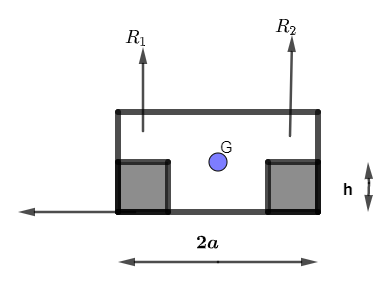
A car is moving on a circular path and takes a turn. If ${R_1}$ and ${R_2}$ be the reactions on the inner and outer wheels respectively, then
A. ${R_1} = {R_2}$
B. ${R_1} < {R_2}$
C. ${R_1} > {R_2}$
D. ${R_1} \geqslant {R_2}$
Answer
216.3k+ views
Hint: In order to solve this question, we will first draw the rough diagram of wheels of the car and then indicate their normal reactions and then using concept of moment about the centre of gravity of the car we will determine the correct relation between normal reactions of the wheels.
Complete step by step solution:
According to the question, we have given that A car is moving on a circular path and takes a turn and in this ${R_1}$ and ${R_2}$ be the reactions on the inner and outer wheels, while turning the horizontal force required to make a turn is centripetal force f which is given by,
$f = \dfrac{{M{v^2}}}{r}$
where m is the mass, v is the velocity and r is the radius of the circular path.
Let us draw the free body diagram of wheels of the car where height of the wheel is h and distance between two wheels is $2a$ and G is the point of centre of gravity of the car as shown in the diagram

Now, if the car is turning towards left as shown in the diagram then on balancing vertical force we have,
${R_1} + {R_2} = Mg$
Now, taking the moments of vertical forces and horizontal forces about the point G, we get;
$Fh + {R_1}a = {R_2}a \\
\Rightarrow {R_2} = \dfrac{{Fh + {R_1}a}}{a} \\
\Rightarrow {R_2} = {R_1} + \dfrac{{Fh}}{a} \\ $
$\therefore {R_2} > {R_1}$
Hence, the correct answer is option B.
Note: It should be remembered that, if the car was taking the turn towards right then these reactions will be exactly opposite as horizontal centripetal force will act towards right and always make the free body diagram to solve such questions.
Complete step by step solution:
According to the question, we have given that A car is moving on a circular path and takes a turn and in this ${R_1}$ and ${R_2}$ be the reactions on the inner and outer wheels, while turning the horizontal force required to make a turn is centripetal force f which is given by,
$f = \dfrac{{M{v^2}}}{r}$
where m is the mass, v is the velocity and r is the radius of the circular path.
Let us draw the free body diagram of wheels of the car where height of the wheel is h and distance between two wheels is $2a$ and G is the point of centre of gravity of the car as shown in the diagram

Now, if the car is turning towards left as shown in the diagram then on balancing vertical force we have,
${R_1} + {R_2} = Mg$
Now, taking the moments of vertical forces and horizontal forces about the point G, we get;
$Fh + {R_1}a = {R_2}a \\
\Rightarrow {R_2} = \dfrac{{Fh + {R_1}a}}{a} \\
\Rightarrow {R_2} = {R_1} + \dfrac{{Fh}}{a} \\ $
$\therefore {R_2} > {R_1}$
Hence, the correct answer is option B.
Note: It should be remembered that, if the car was taking the turn towards right then these reactions will be exactly opposite as horizontal centripetal force will act towards right and always make the free body diagram to solve such questions.
Recently Updated Pages
JEE Atomic Structure and Chemical Bonding important Concepts and Tips

JEE Amino Acids and Peptides Important Concepts and Tips for Exam Preparation

Electricity and Magnetism Explained: Key Concepts & Applications

Chemical Properties of Hydrogen - Important Concepts for JEE Exam Preparation

JEE Energetics Important Concepts and Tips for Exam Preparation

JEE Isolation, Preparation and Properties of Non-metals Important Concepts and Tips for Exam Preparation

Trending doubts
JEE Main 2026: Application Form Open, Exam Dates, Syllabus, Eligibility & Question Papers

Derivation of Equation of Trajectory Explained for Students

Hybridisation in Chemistry – Concept, Types & Applications

Understanding the Angle of Deviation in a Prism

Understanding Collisions: Types and Examples for Students

How to Convert a Galvanometer into an Ammeter or Voltmeter

Other Pages
JEE Advanced Marks vs Ranks 2025: Understanding Category-wise Qualifying Marks and Previous Year Cut-offs

Units And Measurements Class 11 Physics Chapter 1 CBSE Notes - 2025-26

NCERT Solutions For Class 11 Physics Chapter 8 Mechanical Properties Of Solids

Motion in a Straight Line Class 11 Physics Chapter 2 CBSE Notes - 2025-26

NCERT Solutions for Class 11 Physics Chapter 7 Gravitation 2025-26

Ideal and Non-Ideal Solutions Explained for Class 12 Chemistry




